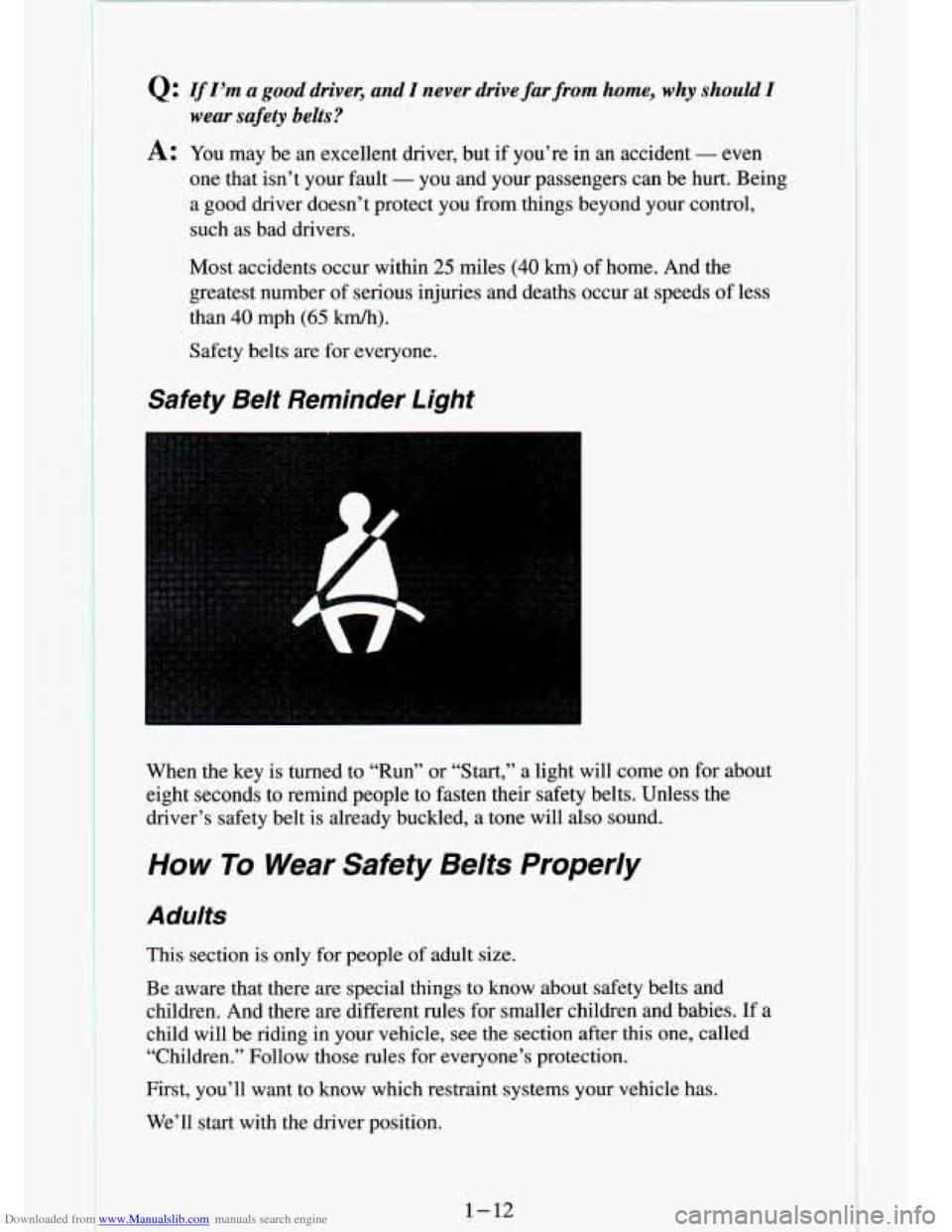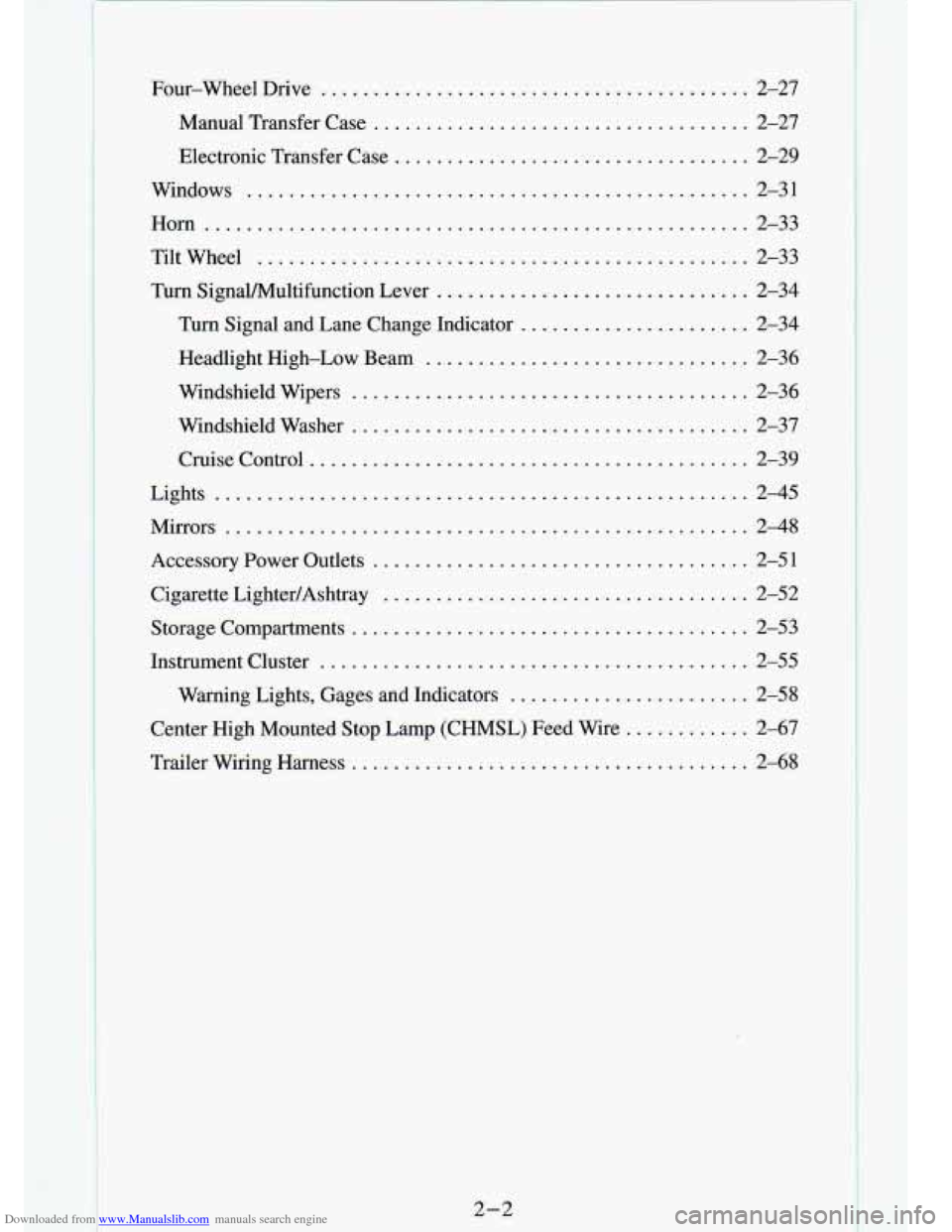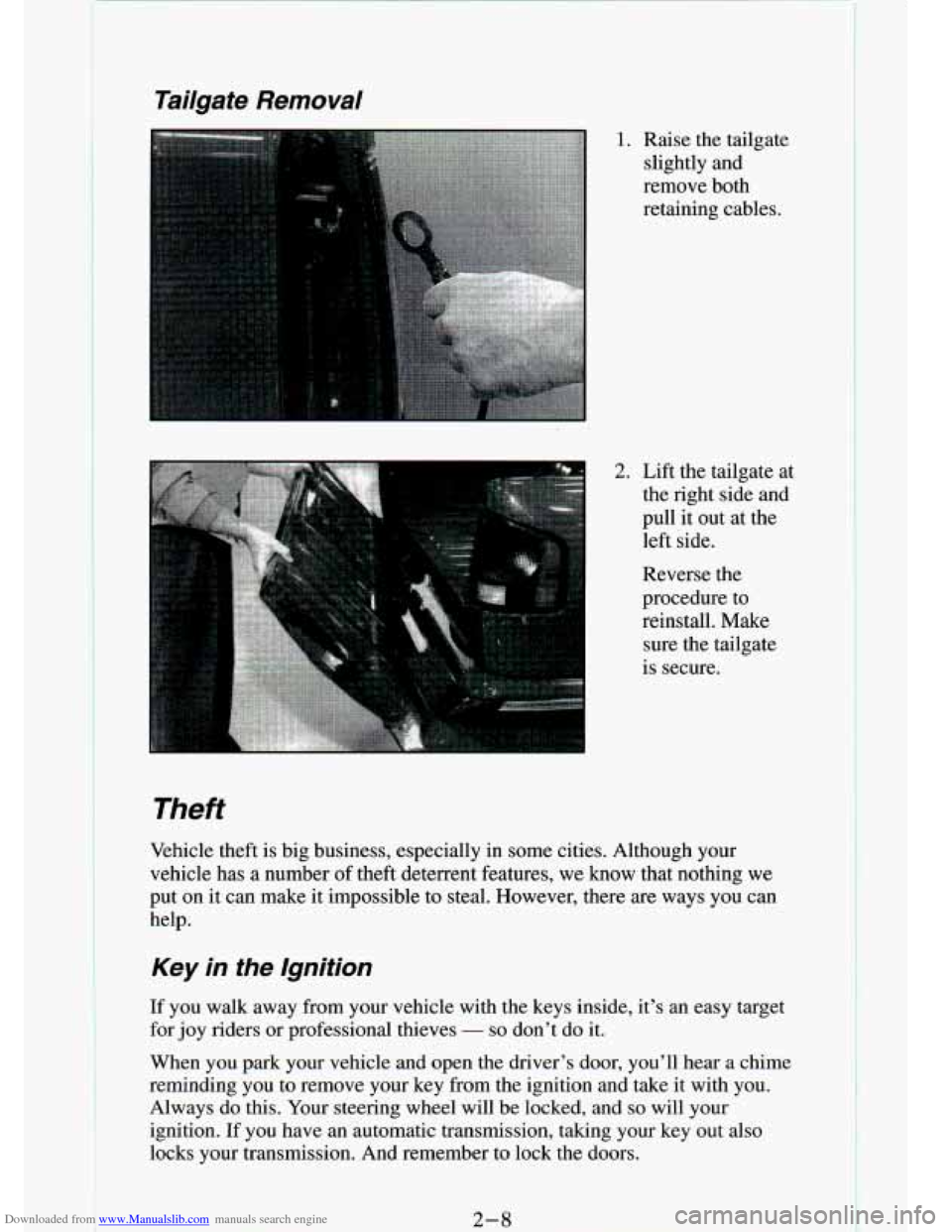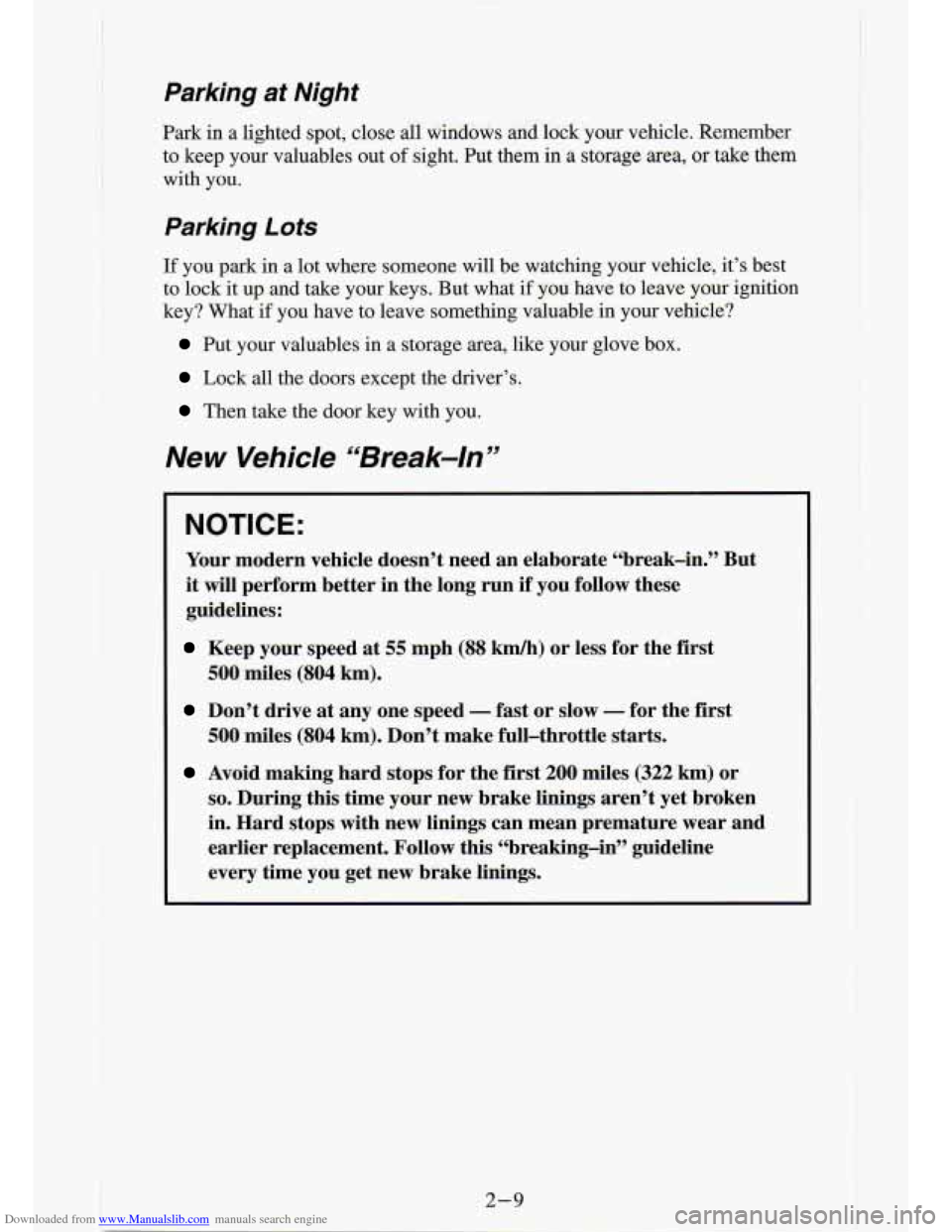Page 10 of 340
Downloaded from www.Manualslib.com manuals search engine These symbols are important for you and your passengers whenever vour
vehicle is driven:
2U
Fasten Safety Door LocwUnlock
Belts
These symbols have to do with your lights:
Master Lighting
Switch Turn
Signal
Direction
**.*:o .e.
Parking Lights Daytime
Running Lights
A
Hazard Warning Flasher
I Fog Lights Headlight
High Beam
viii.
Page 11 of 340
Downloaded from www.Manualslib.com manuals search engine These symbols are on some of your controls:
Windshield Washer Windshield
Defroster Windshield
Wiper
I
Ventilating Fan
These symbols are used on warning and indicator lights:
Engine Coolant
Temperature
BRAKE
Brake Battery Charging
System
I SHIFT
I
Shift Light Fuel
0
Off
Engine Oil
Pressure
Page 12 of 340
Downloaded from www.Manualslib.com manuals search engine n ;are s ler symbols you may see:
t
m
Fuse Hood Release Lighter Horn
Page 19 of 340
Downloaded from www.Manualslib.com manuals search engine Safety Belts: They’re For Everyone
This part of the manual tells you how to use safety belts properly. It also
tells you some things you should not do with safety belts.
I,
This figure lights up as a reminder to bucklk up. (See “Safety Belt Reminder
Light” in the Index.)
In many states and Canadian provinces, the law says to wear safet\
y belts.
Here’s why:
They work.
You never know if you’ll be in a crash. If you do have a crash, you don’t
know if it will be
a bad one.
A few crashes are mild, and some crashes can be so serious that even
buckled up a person wouldn’t survive. But most crashes are in between.
In
many of them, people who buckle up can survive and sometimes walk away\
.
Without belts they could have been badly hurt or killed.
Page 24 of 340

Downloaded from www.Manualslib.com manuals search engine 0: If I’m a good drive4 and I never drive farfium home, why should I
A: You may be an excellent driver, but if you’re in an accident - even
wear safety belts?
one that isn’t your fault - you and your passengers can be hurt. Being
a good driver doesn’t protect you from things beyond your control,
such as bad drivers.
Most accidents occur within
25 miles (40 km) of home. And the
greatest number of serious injuries and deaths occur at speeds of less
than
40 mph (65 km/h).
Safety belts are for everyone.
Safety Belt Reminder Light
When the key is turned to “Run” or “Start,” a light will come on for about
eight seconds to remind people to fasten their safety belts. U\
nless the
driver’s safety belt is already buckled, a tone will also sound.
How To Wear Safety Belts Properly
Adults
This section is only for people of adult size.
Be aware that there are special things to know about safety b\
elts and children. And there are different rules for smaller children and babies. If a
child will be riding
in your vehicle, see the section after this one, called
“Children.” Follow those rules for everyone’s protection.\
rlrsz, you’ll want to know which restraint systems your vehicle has\
.
We’ll start with the driver position.
1-12
I
Page 48 of 340

Downloaded from www.Manualslib.com manuals search engine ...
.
Four-wheel Drive ......................................... 2-27
Manual Transfer Case
.................................... 2-27
Electronic Transfer Case
.................................. 2-29
Windows
................................................ 2-31
Horn
.................................................... 2-33
TiltWheel
............................................... 2-33
Turn SignaYMultifunction Lever
.............................. 2-34
Turn Signal and Lane Change Indicator
...................... 2-34
Headlight High-Low Beam
............................... 2-36
Windshield Wipers
...................................... 2-36
Windshield Washer
...................................... 2-37
Cruise Control
.......................................... 2-39
Lights
................................................... 2-45
Mirrors
.................................................. 2-48
Accessory Power Outlets
.................................... 2-51
Cigarette LightedAshtray ................................... 2-52
Storage Compartments ...................................... 2-53
Instrument Cluster
......................................... 2-55
Wamrng Lights, Gages and Indicators
....................... 2-58
Center High Mounted Stop Lamp (CHMSL) Feed Wire
............ 2-67
Trailer Wiring Harness
...................................... 2-68
2-2
Page 54 of 340

Downloaded from www.Manualslib.com manuals search engine Tailgate Removal
Theft
1.
2.
Raise the tailgate slightly and
remove both
retaining cables.
Lift the tailgate at the right side and
pull
it out at the
left side.
Reverse the
procedure to
reinstall. Make sure the tailgate
is secure.
Vehicle theft is big business, especially in some cities. Altho\
ugh your vehicle has
a number of theft deterrent features, we know that nothing we
put on it can make it impossible to steal. However, there are ways you can
help.
Key in the Ignition
If you walk away from your vehicle with the keys inside, it’s an easy target
for joy riders or professional thieves
- so don’t do it.
When you park your vehicle and open the driver’s door, you’\
ll hear a chime
reminding you to remove your key from the ignition and take i\
t with you.
Always do this. Your steering wheel will be locked, and
so will your
ignition.
If you have an automatic transmission, taking your key out also
locks your transmission. And remember to lock the doors.
2-8
Page 55 of 340

Downloaded from www.Manualslib.com manuals search engine Parking at Night
Park in a lighted spot, close all windows and lock your vehicle. Remember
to keep your valuables out
of sight. Put them in a storage area, or take them
with you.
Parking Lots
If you park in a lot where someone will be watching your vehicle, it’s best
to lock it up and take your keys. But what if you have to leave your ignition
key? What if you have to leave something valuable
in your vehicle?
Put your valuables in a storage area, like your glove box.
Lock all the doors except the driver’s.
Then take the door key with you.
New Vehicle “Break-In”
NOTICE:
Your modern vehicle doesn’t need an elaborate ‘70reak-in.” But
it will perform better in the long run if‘ you follow these
guidelines:
Keep your speed at 55 mph (88 km/h) or less for the first
500 miles (804 km).
Don’t drive at any one speed - fast or slow - for the first
500 miles (804 km). Don’t make full-throttle starts.
Avoid making hard stops for the first 200 miles (322 km) or
so. During this time your new brake linings aren’t yet broken
in. Hard stops with new linings can mean premature wear and
earlier replacement. Follow this “b’reaking-in” guideline
every time you get new brake linings.
2-9